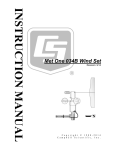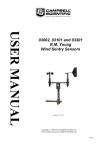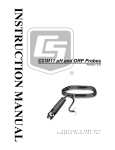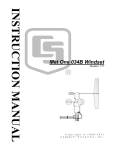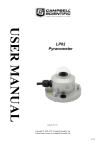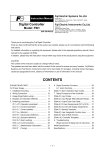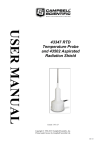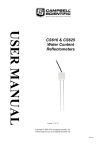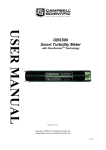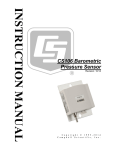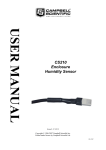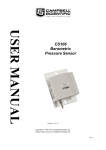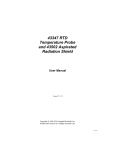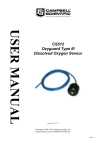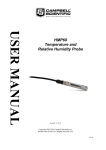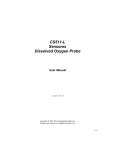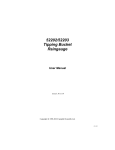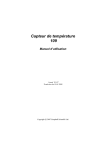Download LWS Decagon - Campbell Scientific
Transcript
USER MANUAL LWS Dielectric Leaf Wetness Sensor Issued: 14.4.15 Copyright © 2008-2015 Campbell Scientific, Inc. Printed under licence by Campbell Scientific Ltd. CSL 771 Guarantee This equipment is guaranteed against defects in materials and workmanship. This guarantee applies for 24 months from date of delivery. We will repair or replace products which prove to be defective during the guarantee period provided they are returned to us prepaid. The guarantee will not apply to: Equipment which has been modified or altered in any way without the written permission of Campbell Scientific Batteries Any product which has been subjected to misuse, neglect, acts of God or damage in transit. Campbell Scientific will return guaranteed equipment by surface carrier prepaid. Campbell Scientific will not reimburse the claimant for costs incurred in removing and/or reinstalling equipment. This guarantee and the Company’s obligation thereunder is in lieu of all other guarantees, expressed or implied, including those of suitability and fitness for a particular purpose. Campbell Scientific is not liable for consequential damage. Please inform us before returning equipment and obtain a Repair Reference Number whether the repair is under guarantee or not. Please state the faults as clearly as possible, and if the product is out of the guarantee period it should be accompanied by a purchase order. Quotations for repairs can be given on request. It is the policy of Campbell Scientific to protect the health of its employees and provide a safe working environment, in support of this policy a “Declaration of Hazardous Material and Decontamination” form will be issued for completion. When returning equipment, the Repair Reference Number must be clearly marked on the outside of the package. Complete the “Declaration of Hazardous Material and Decontamination” form and ensure a completed copy is returned with your goods. Please note your Repair may not be processed if you do not include a copy of this form and Campbell Scientific Ltd reserves the right to return goods at the customers’ expense. Note that goods sent air freight are subject to Customs clearance fees which Campbell Scientific will charge to customers. In many cases, these charges are greater than the cost of the repair. Campbell Scientific Ltd, 80 Hathern Road, Shepshed, Loughborough, LE12 9GX, UK Tel: +44 (0) 1509 601141 Fax: +44 (0) 1509 601091 Email: [email protected] www.campbellsci.co.uk PLEASE READ FIRST About this manual Please note that this manual was originally produced by Campbell Scientific Inc. primarily for the North American market. Some spellings, weights and measures may reflect this origin. Some useful conversion factors: Area: 1 in2 (square inch) = 645 mm2 Length: 1 in. (inch) = 25.4 mm 1 ft (foot) = 304.8 mm 1 yard = 0.914 m 1 mile = 1.609 km Mass: 1 oz. (ounce) = 28.35 g 1 lb (pound weight) = 0.454 kg Pressure: 1 psi (lb/in2) = 68.95 mb Volume: 1 UK pint = 568.3 ml 1 UK gallon = 4.546 litres 1 US gallon = 3.785 litres In addition, while most of the information in the manual is correct for all countries, certain information is specific to the North American market and so may not be applicable to European users. Differences include the U.S standard external power supply details where some information (for example the AC transformer input voltage) will not be applicable for British/European use. Please note, however, that when a power supply adapter is ordered it will be suitable for use in your country. Reference to some radio transmitters, digital cell phones and aerials may also not be applicable according to your locality. Some brackets, shields and enclosure options, including wiring, are not sold as standard items in the European market; in some cases alternatives are offered. Details of the alternatives will be covered in separate manuals. Part numbers prefixed with a “#” symbol are special order parts for use with non-EU variants or for special installations. Please quote the full part number with the # when ordering. Recycling information At the end of this product’s life it should not be put in commercial or domestic refuse but sent for recycling. Any batteries contained within the product or used during the products life should be removed from the product and also be sent to an appropriate recycling facility. Campbell Scientific Ltd can advise on the recycling of the equipment and in some cases arrange collection and the correct disposal of it, although charges may apply for some items or territories. For further advice or support, please contact Campbell Scientific Ltd, or your local agent. Campbell Scientific Ltd, Campbell Park, 80 Hathern Road, Shepshed, Loughborough, LE12 9GX, UK Tel: +44 (0) 1509 601141 Fax: +44 (0) 1509 601091 Email: [email protected] www.campbellsci.co.uk Precautions DANGER — MANY HAZARDS ARE ASSOCIATED WITH INSTALLING, USING, MAINTAINING, AND WORKING ON OR AROUND TRIPODS, TOWERS, AND ANY ATTACHMENTS TO TRIPODS AND TOWERS SUCH AS SENSORS, CROSSARMS, ENCLOSURES, ANTENNAS, ETC. FAILURE TO PROPERLY AND COMPLETELY ASSEMBLE, INSTALL, OPERATE, USE, AND MAINTAIN TRIPODS, TOWERS, AND ATTACHMENTS, AND FAILURE TO HEED WARNINGS, INCREASES THE RISK OF DEATH, ACCIDENT, SERIOUS INJURY, PROPERTY DAMAGE, AND PRODUCT FAILURE. TAKE ALL REASONABLE PRECAUTIONS TO AVOID THESE HAZARDS. CHECK WITH YOUR ORGANIZATION'S SAFETY COORDINATOR (OR POLICY) FOR PROCEDURES AND REQUIRED PROTECTIVE EQUIPMENT PRIOR TO PERFORMING ANY WORK. Use tripods, towers, and attachments to tripods and towers only for purposes for which they are designed. Do not exceed design limits. Be familiar and comply with all instructions provided in product manuals. Manuals are available at www.campbellsci.eu or by telephoning +44(0) 1509 828 888 (UK). You are responsible for conformance with governing codes and regulations, including safety regulations, and the integrity and location of structures or land to which towers, tripods, and any attachments are attached. Installation sites should be evaluated and approved by a qualified engineer. If questions or concerns arise regarding installation, use, or maintenance of tripods, towers, attachments, or electrical connections, consult with a licensed and qualified engineer or electrician. General • Prior to performing site or installation work, obtain required approvals and permits. Comply with all governing structure-height regulations, such as those of the FAA in the USA. • Use only qualified personnel for installation, use, and maintenance of tripods and towers, and any attachments to tripods and towers. The use of licensed and qualified contractors is highly recommended. • Read all applicable instructions carefully and understand procedures thoroughly before beginning work. • Wear a hardhat and eye protection, and take other appropriate safety precautions while working on or around tripods and towers. • Do not climb tripods or towers at any time, and prohibit climbing by other persons. Take reasonable precautions to secure tripod and tower sites from trespassers. • Use only manufacturer recommended parts, materials, and tools. Utility and Electrical • You can be killed or sustain serious bodily injury if the tripod, tower, or attachments you are installing, constructing, using, or maintaining, or a tool, stake, or anchor, come in contact with overhead or underground utility lines. • Maintain a distance of at least one-and-one-half times structure height, or 20 feet, or the distance required by applicable law, whichever is greater, between overhead utility lines and the structure (tripod, tower, attachments, or tools). • Prior to performing site or installation work, inform all utility companies and have all underground utilities marked. • Comply with all electrical codes. Electrical equipment and related grounding devices should be installed by a licensed and qualified electrician. Elevated Work and Weather • Exercise extreme caution when performing elevated work. • Use appropriate equipment and safety practices. • During installation and maintenance, keep tower and tripod sites clear of un-trained or non-essential personnel. Take precautions to prevent elevated tools and objects from dropping. • Do not perform any work in inclement weather, including wind, rain, snow, lightning, etc. Maintenance • Periodically (at least yearly) check for wear and damage, including corrosion, stress cracks, frayed cables, loose cable clamps, cable tightness, etc. and take necessary corrective actions. • Periodically (at least yearly) check electrical ground connections. WHILE EVERY ATTEMPT IS MADE TO EMBODY THE HIGHEST DEGREE OF SAFETY IN ALL CAMPBELL SCIENTIFIC PRODUCTS, THE CUSTOMER ASSUMES ALL RISK FROM ANY INJURY RESULTING FROM IMPROPER INSTALLATION, USE, OR MAINTENANCE OF TRIPODS, TOWERS, OR ATTACHMENTS TO TRIPODS AND TOWERS SUCH AS SENSORS, CROSSARMS, ENCLOSURES, ANTENNAS, ETC. Contents PDF viewers: These page numbers refer to the printed version of this document. Use the PDF reader bookmarks tab for links to specific sections. 1. Introduction ................................................................ 1 2. Cautionary Statements .............................................. 1 3. Initial Inspection ........................................................ 1 4. Quickstart ................................................................... 1 5. Overview ..................................................................... 4 5.1 5.2 Measurement ........................................................................................ 4 Leaf Mimicry ....................................................................................... 4 6. Specifications ............................................................ 5 7. Installation .................................................................. 5 7.1 7.2 7.3 Field Installation .................................................................................. 5 Wiring .................................................................................................. 6 Programming........................................................................................ 6 7.3.1 Voltage Measurement ................................................................... 7 7.3.2 Interpreting Data ........................................................................... 7 8. Maintenance ............................................................... 8 9. Acknowledgement ..................................................... 9 Appendices A. Importing Short Cut Code Into a Program Editor .................................................................... A-1 B. Example Programs ................................................ B-1 B.1 B.2 Example CR1000 Program .............................................................. B-1 Example CR6 Program .................................................................... B-2 7-1. 7-2. 7-3. LWS Dielectric Leaf Wetness Sensor .................................................. 6 Top view of a typical LWS installation ............................................... 6 Typical LWS response ......................................................................... 8 Figures i Tables B-1. B-2. CR1000 Example Wiring ................................................................. B-1 CR6 Example Wiring ....................................................................... B-2 ii LWS Dielectric Leaf Wetness Sensor 1. Introduction Direct measurement of leaf wetness is problematic. Secure long-term attachment of a sensor to a representative living leaf is difficult. Leaf position, sun exposure, and health are in constant flux. To avoid these problems, leaf wetness sensors have been developed to estimate by inference the wetness of nearby leaves. The LWS estimates leaf surface wetness by measuring the dielectric constant of the sensor’s upper surface. The sensor is able to detect the presence of miniscule amounts of water or ice. Individual sensor calibration is not normally necessary. NOTE 2. 3. 4. This manual provides information only for CRBasic dataloggers. It is also compatible with most of our retired Edlog dataloggers. For Edlog datalogger support, see an older manual at www.campbellsci.com/old-manuals or contact a Campbell Scientific application engineer for assistance. Cautionary Statements READ AND UNDERSTAND the Precautions section at the front of this manual. Care should be taken when opening the shipping package to not damage or cut the cable jacket. If damage to the cable is suspected, consult with a Campbell Scientific application engineer. Although the LWS is rugged, it should be handled as a precision scientific instrument. Over time, the accumulation of dust and bird droppings can cause the dry output to rise. We recommend that the sensor be periodically cleaned using a moist cloth, or when you detect elevated dry output. The LWS is intended only for applications wherein the datalogger provides short excitation, leaving the probe quiescent most of the time. Continuous excitation may cause the probe to exceed government specified limits on electromagnetic emissions. Initial Inspection Upon receipt of the LWS, inspect the packaging and contents for damage. File damage claims with the shipping company. The model number and cable length are printed on a label at the connection end of the cable. Check this information against the shipping documents to ensure the correct product and cable length are received. Quickstart Short Cut is an easy way to program your datalogger to measure the LWS and assign datalogger wiring terminals. The following procedure shows using Short Cut to program the LWS. 1 LWS Dielectric Leaf Wetness Sensor 2 1. Install Short Cut by clicking on the install file icon. Get the install file from either www.campbellsci.com, the ResourceDVD, or find it in installations of LoggerNet, PC200W, PC400, or RTDAQ software. 2. The Short Cut installation should place a Short Cut icon on the desktop of your computer. To open Short Cut, click on this icon. 3. When Short Cut opens, select New Program. User Manual 4. Select Datalogger Model and Scan Interval (default of 5 seconds is OK for most applications). Click Next. 5. Under the Available Sensors and Devices list, select the Sensors | Miscellaneous Sensors folder. Select LWS Dielectric Leaf Wetness Sensor. Click to move the selection to the Selected device window. Enter the Dry threshold (mV) < and Wet threshold (mV) >= values (see Section 7.3.2, Interpreting Data (p. 7), for information about determining the dry threshold and wet threshold values). 3 LWS Dielectric Leaf Wetness Sensor 5. 6. After selecting the sensor, click at the left of the screen on Wiring Diagram to see how the sensor is to be wired to the datalogger. The wiring diagram can be printed out now or after more sensors are added. 7. Select any other sensors you have, then finish the remaining Short Cut steps to complete the program. The remaining steps are outlined in Short Cut Help, which is accessed by clicking on Help | Contents | Programming Steps. 8. If LoggerNet, PC400, RTDAQ, or PC200W is running on your PC, and the PC to datalogger connection is active, you can click Finish in Short Cut and you will be prompted to send the program just created to the datalogger. 9. If the sensor is connected to the datalogger, as shown in the wiring diagram in step 6, check the output of the sensor in the datalogger support software data display to make sure it is making reasonable measurements. Overview 5.1 Measurement The LWS measures the dielectric constant of a zone approximately 1 cm from the upper surface of the sensor. The dielectric constant of water (≈80) and ice (≈5) are much higher than that of air (≈1), so the measured dielectric constant is strongly dependent on the presence of moisture or frost on the sensor surfaces. The sensor outputs an mV signal proportional to the dielectric of the measurement zone, and therefore proportional to the amount of water or ice on the sensor surface. 5.2 Leaf Mimicry The LWS is designed to approximate the thermodynamic properties of most leaves. If the specific heat of a typical leaf is estimated at 3750 J kg–1 K–1, density estimated at 0.95 g/cm3, and thickness estimated at 0.4 mm, then the heat capacity of the leaf is ≈1425 J m–2 K–1. This heat capacity is closely approximated by the thin (0.65 mm) fiberglass construction of the LWS, which has a heat capacity of 1480 J m–2 K–1. By mimicking the thermodynamic properties of a real leaf, the LWS closely matches the wetness state of the canopy. 4 User Manual The sensor closely matches the radiative properties of real leaves. Healthy leaves generally absorb solar radiation in much of the visible portion of the spectrum, but selectively reject much of the energy in the near-infrared. The surface coating of the LWS absorbs well in the near-infrared region, but the white colour reflects most of the visible radiation. Spectroradiometer measurements indicate that the overall radiation balance of the sensor closely matches that of a healthy leaf. During normal use, prolonged exposure to sunlight can cause some yellowing of the coating, which does not affect the probe’s function. The surface coating is hydrophobic — similar to a leaf with a hydrophobic cuticle. The sensor should match the wetness state of these types of leaves well, but may not match the wetness duration of pubescent leaves or leaves with less waxy cuticles. 6. Specifications Features: 7. Imitates characteristics of a leaf Does not require painting or calibration of individual sensors Detects trace amounts of water or ice on the leaf surface Compatible with Campbell Scientific CRBasic dataloggers: CR6, CR200(X) series, CR800, CR850, CR1000, CR3000, CR5000, and CR9000(X) Measurement Time: 10 ms Excitation: 2.5 Vdc (2 mA) to 5.0 Vdc (7 mA) Minimum Excitation Time: 10 mS Output: 10% to 50% of excitation Operating Temperature: –20 to 60 °C Probe Dimensions: 11.2 cm x 5.8 cm x .075 cm Maximum Lead Length: 76 m (250 ft) Interchangeability: Interchangeable without painting or individual calibration Installation If you are programming your datalogger with Short Cut, skip Section 7.2, Wiring (p. 6), and Section 7.3, Programming (p. 6). Short Cut does this work for you. See Section 4, Quickstart (p. 1), for a Short Cut tutorial. 7.1 Field Installation The LWS is designed to be mounted on a small diameter rod. Deployment in a plant canopy or on a weather station mast is typical. Two holes in the sensor body are available for mounting with zip ties or 4-40 bolts (Figure 7-1 and Figure 7-2). 5 LWS Dielectric Leaf Wetness Sensor Figure 7-1. LWS Dielectric Leaf Wetness Sensor Figure 7-2. Top view of a typical LWS installation 7.2 Wiring Table 7-1. Wire Colour, Function and Datalogger Connection 7.3 Colour Function CR200(X), CR6, CR800/850, CR5000, CR3000, CR1000, CR9000(X) White Voltage Excitation Switched Voltage Excitation Red Analogue Out Single-Ended Channel Bare Analogue Ground ⏚ Programming Short Cut is the best source for up-to-date datalogger programming code. Programming code is needed when creating a program for a new datalogger installation when adding sensors to an existing datalogger program If your data acquisition requirements are simple, you can probably create and maintain a datalogger program exclusively with Short Cut. If your data acquisition needs are more complex, the files that Short Cut creates are a great 6 User Manual source for programming code to start a new program or add to an existing custom program. NOTE Short Cut cannot edit programs after they are imported and edited in CRBasic Editor. A Short Cut tutorial is available in Section 4, Quickstart (p. 1). If you wish to import Short Cut code into CRBasic Editor to create or add to a customized program, follow the procedure in Appendix A, Importing Short Cut Code into a Program Editor (p. A-1). Programming basics for CRBasic dataloggers are provided in the following sections. A complete program example for a CRBasic datalogger can be found in Appendix B, Example Programs (p. B-1). Programming basics and programming examples for Edlog dataloggers are provided at www.campbellsci.com/old-manuals. 7.3.1 Voltage Measurement The LWS requires excitation voltage between 2.5 and 5 Vdc. It produces an output voltage dependent on the dielectric constant of the medium surrounding the probe. Output voltage ranges from 10 to 50% of the excitation voltage. Except for the CR200(X), CRBasic dataloggers use the BRHalf() instruction to measure the probe’s output. The BRHalf() instruction and parameters are as follows: BRHalf(Dest,Reps,Range,SeChan,ExChan,MeasPEx,ExmV,RevEx,Settling,Integ, Mult,Offset) The CR200(X) uses the ExDelSE() CRBasic instruction to measure the probe’s output. The ExDelSE() instruction and parameters are as follows: ExDelSE( Dest, Reps, SEChan, ExChan, ExmV, Delay, Mult, Offset ) 7.3.2 Interpreting Data Many leaf wetness applications, such as phytopathology, require a Boolean interpretation of leaf wetness data such as whether or not water is present. A Boolean threshold is determined by analysing a few days of time series data. Consider time series data in Figure 7-3, which were obtained at 5 Vdc excitation. The sensor yields ≈445 mV when dry, ≈475 mV when frosted, and >475 mV when wet. Therefore, a Boolean wetness threshold of 500 mV should serve well for interpreting these data. 7 LWS Dielectric Leaf Wetness Sensor Figure 7-3. Typical LWS response Duration of leaf wetness can be determined either by post processing of data, or by programming the datalogger to accumulate time of wetness based on the Boolean threshold. Accumulation of dust and debris, such as avian faecal matter, will change the Boolean threshold. So, while having the datalogger accumulate time of leaf wetness, or time of frost, may be convenient, assurance of data quality requires retention of the base mV measurements. NOTE 8. Collect data frequently enough to capture changes in surface wetness. A sample frequency of 15 minutes or less is usually necessary to accurately capture leaf wetness duration. Maintenance Over time, the accumulation of dust and debris will cause the dry output to increase and changing the Boolean threshold. Clean the sensing surface with a moist cloth periodically or when elevated dry output is detected. The LWS leaf wetness sensor is designed to withstand typical outdoor radiation and precipitation loads for greater than two years. If you are using the LWS in areas with non-typical (unusually high) radiation loads, we recommend additional applications of McNett UVTech (available from www.mcnett.com) be reapplied every 45 days. McNett is the only tested and approved UV blocking system for this leaf wetness sensor. To apply McNett UV Tech: 8 1. Wipe sensor clean. 2. Spray sensor surface with McNett UV Tech. 3. Rub with soft cloth until dry. User Manual 9. Acknowledgement Portions of this manual are copyrighted by Decagon Devices, Inc. and are used by permission. 9 LWS Dielectric Leaf Wetness Sensor 10 Appendix A. Importing Short Cut Code into a Program Editor This tutorial shows: How to import a Short Cut program into a program editor for additional refinement How to import a wiring diagram from Short Cut into the comments of a custom program Short Cut creates files that can be imported into either CRBasic Editor or Edlog program editor. These files normally reside in the C:\campbellsci\SCWin folder and have the following extensions: .DEF (wiring and memory usage information) .CR2 (CR200(X) datalogger code) .CR6 (CR6 datalogger code) .CR1 (CR1000 datalogger code) .CR8 (CR800 or CR850 datalogger code) .CR3 (CR3000 datalogger code) .CR5 (CR5000 datalogger code) Use the following procedure to import Short Cut code into CRBasic Editor (CR200(X), CR6, CR1000, CR800, CR850, CR3000, CR5000 dataloggers). NOTE 1. Create the Short Cut program following the procedure in Section 4, Quickstart (p. 1). Finish the program and exit Short Cut. Make note of the file name used when saving the Short Cut program. 2. Open CRBasic Editor. 3. Click File | Open. Assuming the default paths were used when Short Cut was installed, navigate to C:\CampbellSci\SCWin folder. The file of interest has a “.CR2”, “.CR6”, “.CR1”, “.CR8”, “.CR3”, or “.CR5” extension, for CR200(X), CR6, CR1000, CR800/CR850, CR3000, or CR5000 dataloggers, respectively. Select the file and click Open. 4. Immediately save the file in a folder different from \Campbellsci\SCWin, or save the file with a different file name. Once the file is edited with CRBasic Editor, Short Cut can no longer be used to edit the datalogger program. Change the name of the program file or move it, or Short Cut may overwrite it next time it is used. 5. The program can now be edited, saved, and sent to the datalogger. 6. Import wiring information to the program by opening the associated .DEF file. Copy and paste the section beginning with heading “-Wiring for CRXXX–” into the CRBasic program, usually at the head of the file. After pasting, edit the information such that a ' character (single quotation mark) begins each line. This character instructs the datalogger compiler to ignore the line when compiling the datalogger code. A-1 Appendix A. Importing Short Cut Code Into a Program Editor A-2 Appendix B. Example Programs B.1 Example CR1000 Program The wiring for the example is shown in Table B-1. Table B-1. CR1000 Example Wiring Colour Function CR1000 White Excitation EX1 or VX1 Red Analogue Out SE1 Bare Analogue Ground ⏚ 'CR1000 'Declare Variables and Units Public BattV Public PTemp_C Public LWmV Public LWMDry Public LWMCon Public LWMWet Units Units Units Units Units Units BattV=Volts PTemp_C=Deg C LWmV=mV LWMDry=Minutes LWMCon=Minutes LWMWet=Minutes 'Define Data Tables DataTable(Table1,True,-1) DataInterval(0,60,Min,10) Sample(1,BattV,FP2) Sample(1,PTemp_C,FP2) Sample(1,LWmV,FP2) Totalize(1,LWMDry,FP2,False) Totalize(1,LWMCon,FP2,False) Totalize(1,LWMWet,FP2,False) EndTable DataTable(Table2,True,-1) DataInterval(0,1440,Min,10) Minimum(1,BattV,FP2,False,False) EndTable 'Main Program BeginProg 'Main Scan Scan(5,Sec,1,0) 'Default Datalogger Battery Voltage measurement 'BattV' Battery(BattV) 'Default Wiring Panel Temperature measurement 'PTemp_C' PanelTemp(PTemp_C,_60Hz) 'LWS Dielectric Leaf Wetness Sensor measurement 'LWmV' BrHalf(LWmV,1,mV2500,1,1,1,2500,False,10000,_60Hz,2500,0) 'Determine Minutes Dry, LWMDry, Minutes Wet or Contaminated, ‘LWMCon, and Minutes Wet, LWMWet for this Scan LWMDry=0 LWMCon=0 LWMWet=0 B-1 Appendix B. Example Programs If LWmV<274 Then LWMDry=0.08333333 Else If LWmV>=284 Then LWMWet=0.08333333 Else LWMCon=0.08333333 EndIf EndIf 'Call Data Tables and Store Data CallTable(Table1) CallTable(Table2) NextScan EndProg B.2 Example CR6 Program The wiring for the example is shown in Table B-2. Table B-2. CR6 Example Wiring Colour Function CR6 White Excitation U1 Red Analogue Out U2 Bare Analogue Ground ⏚ 'CR6 Series 'Declare Variables and Units Public BattV Public PTemp_C Public LWmV Public LWMDry Public LWMCon Public LWMWet Units Units Units Units Units Units BattV=Volts PTemp_C=Deg C LWmV=mV LWMDry=Minutes LWMCon=Minutes LWMWet=Minutes 'Define Data Tables DataTable(Table1,True,-1) DataInterval(0,60,Min,10) Sample(1,LWmV,FP2) Totalize(1,LWMDry,FP2,False) Totalize(1,LWMCon,FP2,False) Totalize(1,LWMWet,FP2,False) EndTable B-2 Appendix B. Example Programs DataTable(Table2,True,-1) DataInterval(0,1440,Min,10) Minimum(1,BattV,FP2,False,False) EndTable 'Main Program BeginProg 'Main Scan Scan(5,Sec,1,0) 'Default Datalogger Battery Voltage measurement 'BattV' Battery(BattV) 'Default Wiring Panel Temperature measurement 'PTemp_C' PanelTemp(PTemp_C,60) 'LWS Dielectric Leaf Wetness Sensor measurement 'LWmV' BrHalf(LWmV,1,mV5000,U2,U1,1,2500,False,10000,60,2500,0) 'Determine Minutes Dry 'LWMDry', Minutes Wet or Contaminated 'LWMCon', and Minutes Wet 'LWMWet' for this Scan LWMDry=0 LWMCon=0 LWMWet=0 If LWmV<274 Then LWMDry=0.08333333 Else If LWmV>=284 Then LWMWet=0.08333333 Else LWMCon=0.08333333 EndIf EndIf 'Call Data Tables and Store Data CallTable Table1 CallTable Table2 NextScan EndProg B-3 CAMPBELL SCIENTIFIC COMPANIES Campbell Scientific, Inc. (CSI) 815 West 1800 North Logan, Utah 84321 UNITED STATES www.campbellsci.com [email protected] Campbell Scientific Africa Pty. Ltd. (CSAf) PO Box 2450 Somerset West 7129 SOUTH AFRICA www.csafrica.co.za [email protected] Campbell Scientific Australia Pty. Ltd. (CSA) PO Box 8108 Garbutt Post Shop QLD 4814 AUSTRALIA www.campbellsci.com.au [email protected] Campbell Scientific do Brazil Ltda. (CSB) Rua Apinagés, nbr. 2018 - Perdizes CEP: 01258-00 São Paulo SP BRAZIL www.campbellsci.com.br [email protected] Campbell Scientific Canada Corp. (CSC) 14532 – 131 Avenue NW Edmonton, Alberta T5L 4X4 CANADA www.campbellsci.ca [email protected] Campbell Scientific Centro Caribe S.A. (CSCC) 300N Cementerio, Edificio Breller Santo Domingo, Heredia 40305 COSTA RICA www.campbellsci.cc [email protected] Campbell Scientific Ltd. (CSL) 80 Hathern Road, Shepshed, Loughborough LE12 9GX UNITED KINGDOM www.campbellsci.co.uk [email protected] Campbell Scientific Ltd. (France) 3 Avenue de la Division Leclerc 92160 ANTONY FRANCE www.campbellsci.fr [email protected] Campbell Scientific Spain, S. L. Avda. Pompeu Fabra 7-9 Local 1 - 08024 BARCELONA SPAIN www.campbellsci.es [email protected] Campbell Scientific Ltd. (Germany) Fahrenheitstrasse13, D-28359 Bremen GERMANY www.campbellsci.de [email protected] Campbell Scientific (Beijing) Co., Ltd. 8B16, Floor 8 Tower B, Hanwei Plaza 7 Guanghua Road, Chaoyang, Beijing 100004 P.R. CHINA www.campbellsci.com [email protected] Please visit www.campbellsci.com to obtain contact information for your local US or International representative.



























